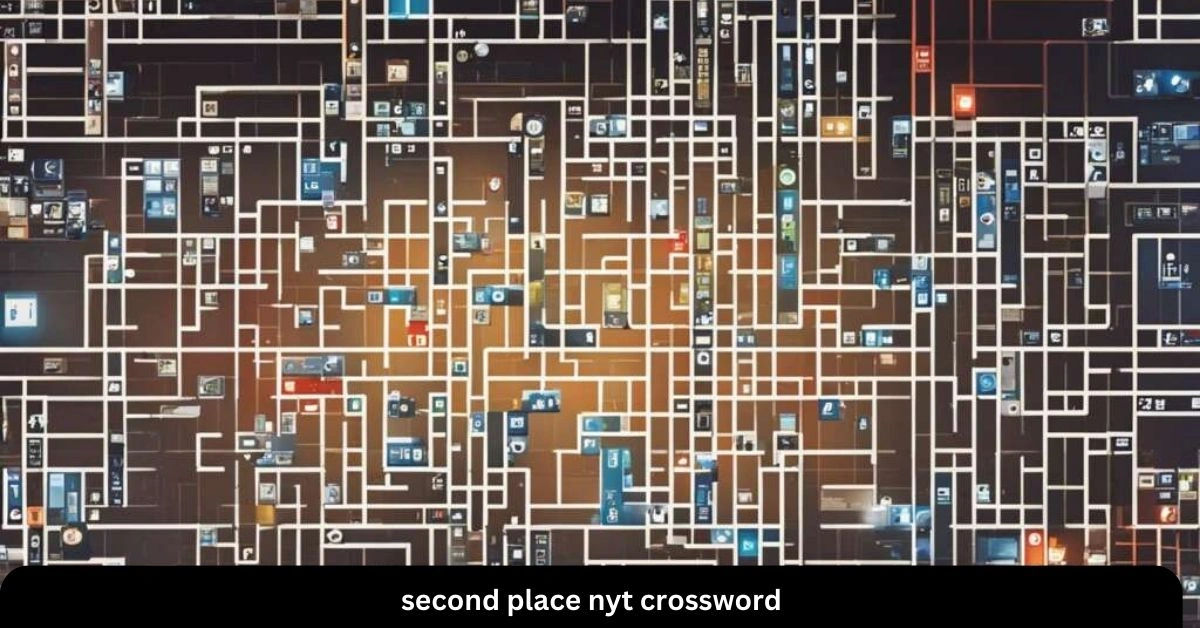Table of Contents
The New York Times crossword has earned a reputation as one of the most iconic and respected puzzles in the world. Whether you are a beginner working through Mondays or a seasoned solver tackling Saturdays, there’s something universally rewarding about completing a puzzle. But let’s take a closer look at something unique—the challenge of landing in second place in the NYT crossword.
While crossword competitions and leaderboards are filled with top-tier solvers aiming for first place, “second place” has its own nuanced charm, frustrations, and value. In this post, we’ll break down what it means to be almost the best, how it feels to solve puzzles with competitiveness in mind, and why second place might even be sweeter than winning.
The Thrill of the NYT Crossword
Solving the NYT crossword is not just a hobby for many—it’s a daily ritual. The puzzles become more difficult as the week progresses, starting with relatively easy Monday puzzles and climaxing with the devilishly difficult Saturday ones. Sundays are large puzzles, with a medium-level difficulty, offering a more time-consuming but fun challenge.
For some people, finishing the puzzle is a quiet personal victory. For others, though, it’s all about solving fast. Competitions like the American Crossword Puzzle Tournament (ACPT) and the NYT’s own online leaderboards make crossword solving a race against the clock. And that’s where second place comes into focus—a bittersweet spot, close to victory but still behind the leader.
Second Place in NYT Crossword Competitions: A Hard Pill or a Badge of Honor?
While coming in second might feel like falling just short, it also represents an incredible achievement. In the competitive world of crosswords, even shaving off a few seconds in speed-solving can make or break the difference between first and second place.
1. The Sting of “Almost Winning”
There’s no sugarcoating it—being second can feel frustrating. Imagine spending hours every day practicing puzzles, only to be beaten by mere seconds. The NYT leaderboard doesn’t care about how close you were; it only highlights the fastest solver. That sting is something many competitors can relate to.
But failure to hit the top spot doesn’t take away the achievement. In a way, second place is proof that you are among the elite solvers. Many crossword champions experienced second place before finally clinching first—it’s part of the journey.
2. Second Place as a Motivator
There’s also something motivating about coming in second. If you’re competitive by nature, the idea of being so close yet missing out will only push you to sharpen your skills. Some solvers treat their second-place finishes as stepping stones. “Next time, I’ll be faster,” they tell themselves.
Interestingly, the data from crossword tournaments shows that second-place finishers often improve faster than those who win repeatedly. Why? Because staying on top can breed complacency, while second place creates hunger.
Second Place on the Daily NYT Crossword Leaderboard
Beyond formal competitions, NYT crossword solvers have a smaller, but equally fierce challenge—the daily online leaderboard. If you solve puzzles using the NYT Crossword app, you know that as soon as you hit “submit,” the timer records your time, and you can see where you stand compared to other solvers.
1. Leaderboard Madness: A Race Against the Clock
The daily leaderboard updates instantly. You might complete the puzzle in under 2 minutes and feel like a champion, only to find out that someone else did it in 1:58. That’s the cruel reality of second place—being milliseconds away from the top but not quite getting there.
Solving puzzles under time pressure changes the way you approach clues. Speed solvers often take wild guesses, relying on quick intuition rather than careful deduction. But sometimes, those quick guesses backfire, costing just enough time to slip into second place.
2. The Frustration of Fast Fingers and Mistakes
Speed solving isn’t just about knowing the answers; it’s about typing quickly and accurately. Typos are a common enemy for solvers aiming for the top spot. Imagine solving the entire grid correctly, only to lose precious seconds fixing a typo. Second place often goes to someone who knew all the answers but stumbled while typing.
Why Second Place Matters More Than You Think
There’s something oddly satisfying about being in second place—especially in the NYT crossword world. For one, second place means you were better than almost everyone else, often by a wide margin. It also suggests that you are just one small tweak away from mastering the puzzle entirely.
In a world obsessed with winning, second place offers a refreshing perspective: it reminds us that the journey matters just as much as the outcome. Crosswords are, after all, about mental agility, pattern recognition, and the joy of problem-solving—not just being the fastest.
Here are a few reasons why second place deserves more credit:
- You’re Still Among the Best: Whether in competitions or leaderboards, being second means you have top-tier skills.
- It’s a Learning Experience: Every second-place finish teaches you something new—about strategy, speed, or even your own solving style.
- It Builds Grit: Second place tests your perseverance. It challenges you to keep going, even when victory feels just out of reach.
Famous Second-Place Finishers in Crossword History
Many legendary crossword solvers have had their fair share of second-place finishes before achieving greatness. For example, Dan Feyer, a seven-time ACPT champion, didn’t win on his first try—he had to work his way up. The journey through second place is what made him stronger.
Second place isn’t a sign of failure—it’s a rite of passage. The same holds true for the everyday solver working their way up the NYT leaderboard. Some days, you’ll be just a few seconds behind the leader. But that only makes it more rewarding when you finally claim the top spot.
Tips to Move from Second to First Place
If you’ve found yourself in second place more often than you’d like, here are a few tips to close the gap:
- Practice Typing Speed: Fast fingers can make a big difference, especially on digital platforms.
- Solve in Patterns: Learn to recognize common crossword clues and fill in answers in clusters, rather than one-by-one.
- Manage Time Wisely: Focus on the easy clues first to build momentum, and circle back to the tricky ones.
- Stay Calm Under Pressure: Speed-solving can be nerve-wracking, but staying composed will prevent mistakes.
The Sweet Spot of Second Place
In the end, coming in second in the NYT crossword world isn’t something to be ashamed of—it’s something to be proud of. Whether you’re solving for fun or aiming for the top of the leaderboard, being “almost there” is still an incredible accomplishment.
Second place offers a unique blend of triumph and motivation. It shows you’re good enough to compete at the highest level, while also reminding you that there’s room to grow. And perhaps that’s what makes second place so special—it’s a constant nudge to improve, to try again, and to enjoy the process along the way.
So the next time you finish a puzzle just seconds behind the leader, take a moment to appreciate how far you’ve come. In a way, second place isn’t the end of the race—it’s just another step on the journey to becoming the best.
Conclusion: Embrace Second Place
The phrase “second place NYT crossword” might sound like a consolation prize, but it’s actually a badge of honor. It signifies dedication, intelligence, and the spirit of healthy competition. Whether you’re chasing the top spot on the leaderboard or working your way through tricky weekend puzzles, second place reminds us that it’s the effort and improvement that matter most.
And who knows? Today’s second place could be tomorrow’s first. Keep solving, stay sharp, and enjoy the ride. The puzzle isn’t just about the destination—it’s about the fun you have along the way.
10 FAQs about Second Place in the NYT Crossword
- What does it mean to get second place in the NYT crossword?
- It refers to solving the puzzle fast enough to rank just behind the top performer, whether on the daily NYT crossword app leaderboard or in crossword competitions like the American Crossword Puzzle Tournament (ACPT).
- Is second place in the NYT crossword frustrating?
- It can be! Many solvers feel the sting of being so close to victory, especially when they lose by mere seconds. However, it’s also an accomplishment that shows you’re among the best.
- Why is second place important in crossword competitions?
- Second place represents elite-level skill and often motivates solvers to push harder. Many champions experienced second place before eventually winning, making it part of the growth process.
- How can I improve from second place to first in crossword competitions?
- Improving typing speed, learning common clue patterns, solving efficiently under pressure, and managing time can help close the gap between second and first place.
- Are there famous solvers who finished second before winning?
- Yes, champions like Dan Feyer, who eventually became a multi-time ACPT winner, had to work through second-place finishes on their journey to the top.
- What makes speed-solving on the NYT leaderboard so challenging?
- Speed-solvers not only need to know the answers but must type fast and accurately. Even minor mistakes, like typos, can cause a drop from first to second place.
- Does coming in second mean I’m not good enough?
- Not at all! Being second shows that you’re solving at a high level. It’s a sign that you are close to mastering the puzzle and just need small adjustments to reach the top.
- How do the NYT crossword leaderboards work?
- When solving through the NYT Crossword app, your time is recorded once you finish the puzzle. You are ranked on a daily leaderboard against other solvers based on completion time.
- Is it better to solve carefully or quickly when aiming for the leaderboard?
- Speed matters for leaderboard rankings, so quick intuition helps. However, mistakes cost time, so finding a balance between speed and accuracy is essential.
- What’s the best way to enjoy the NYT crossword if I keep getting second place?
- Embrace the process! Solving crosswords is about enjoyment and mental agility. Second place can still feel satisfying, and it motivates you to keep improving without losing the joy of solving.






